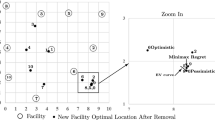Abstract
In this paper, we propose a simple new approach to model lost demand (also referred to as elastic demand) in competitive facility location. A ‘dummy’ competing facility that attracts the lost demand is added to the list of competing facilities. All competitive facility location models, regardless of their complexity or assumptions, can be modified to include lost demand and be solved by the same algorithms designed for standard models once the dummy facility is added to the data as an additional competitor.


Similar content being viewed by others
References
Aboolian R, Berman O and Krass D (2007a). Competitive facility location and design problem. Eur J Opns Res 182: 40–62.
Aboolian R, Berman O and Krass D (2007b). Competitive facility location model with concave demand. Eur J Opns Res 181: 598–619.
Bell DR, Ho T-H and Tang CS (1998). Determining where to shop: Fixed and variable costs of shopping. J Marketing Res 35 (3): 352–369.
Berman O, Drezner T, Drezner Z and Krass D (2009). Modeling competitive facility location problems: New approaches and results. In: Oskoorouchi M (ed). TutORials in Operations Research. INFORMS: San Diego, pp 156–181.
Berman O and Krass D (1998). Flow intercepting spatial interaction model: A new approach to optimal location of competitive facilities. Location Science 6: 41–65.
Drezner T (1994). Optimal continuous location of a retail facility, facility attractiveness, and market share: An interactive model. Journal of Retailing 70: 49–64.
Drezner T (1995). Competitive facility location in the plane. In Drezner Z (ed). Facility Location: A Survey of Applications and Methods. Springer: New York, NY, pp 285–300.
Drezner T (2006). Derived attractiveness of shopping malls. IMA J Manag Math 17: 349–358.
Drezner T and Drezner Z (1997). Replacing discrete demand with continuous demand in a competitive facility location problem. Nav Res Log 44: 81–95.
Drezner T and Drezner Z (1998). Facility location in anticipation of future competition. Location Science 6: 155–173.
Drezner T and Drezner Z (2002). Validating the gravity-based competitive location model using inferred attractiveness. Ann Opns Res 111: 227–237.
Drezner T and Drezner Z (2008). Lost demand in a competitive environment. J Opnl Res Soc 59: 362–371.
Drezner T, Drezner Z and Kalczynski P (2011). A cover-based competitive location model. J Opnl Res Soc 62: 100–113.
Drezner Z (1982). Competitive location strategies for two facilities. Reg Sci Urban Econ 12: 485–493.
Fernandez J, Pelegrin B, Plastria F and Toth B (2007). Solving a Huff-like competitive location and design model for profit maximization in the plane. Eur J Opnl Res 179: 1274–1287.
Ghosh A and Rushton G (1987). Spatial Analysis and Location-Allocation Models. Van Nostrand Reinhold Company: New York, NY.
Hakimi SL (1981). On locating new facilities in a competitive environment. Presented at ISOLDE, Second International Symposium on Location Decisions, Skodsborg; Denmark.
Hakimi SL (1983). On locating new facilities in a competitive environment. Eur J Opnl Res 12: 29–35.
Hodgson MJ (1981). A location-allocation model maximizing consumers’ welfare. Reg Stud 15: 493–506.
Hotelling H (1929). Stability in competition. Econ J 39: 41–57.
Huff DL (1964). Defining and estimating a trade area. J Marketing 28: 34–38.
Huff DL (1966). A programmed solution for approximating an optimum retail location. Land Econ 42: 293–303.
Jain AK and Mahajan V (1979). Evaluating the competitive environment in retailing using multiplicative competitive interactive models. In: Sheth JN (ed). Research in Marketing. Vol. 2 JAI Press: Greenwich, CT, pp 217–235.
Nakanishi M and Cooper LG (1974). Parameter estimate for multiplicative interactive choice model: Least squares approach. J Marketing Res 11: 303–311.
Reilly WJ (1931). The Law of Retail Gravitation. Knickerbocker Press: New York, NY.
Serra D and ReVelle C (1995). Competitive location in discrete space. In: Drezner Z (ed). Facility Location: A Survey of Applications and Methods. Springer: New York, NY, pp 367–386.
Stackelberg HV (1934). Marktform und Gleichgewicht. Julius Springer: Vienne.
Wilson AG (1976). Retailers’ profits and consumers’ welfare in a spatial interaction shopping mode. In: Masser I (ed). Theory and Practice in Regional Science. Pion: London, pp 42–59.
Author information
Authors and Affiliations
Corresponding author
Rights and permissions
About this article
Cite this article
Drezner, T., Drezner, Z. Modelling lost demand in competitive facility location. J Oper Res Soc 63, 201–206 (2012). https://doi.org/10.1057/jors.2011.10
Received:
Accepted:
Published:
Issue Date:
DOI: https://doi.org/10.1057/jors.2011.10




